Exercises
The primary objective is to describe acting techniques and exercises that can be used to improvise on any story. Some are borrowed (Dario Fo, Augusto Boal, Peter Brook, Bob Wilson...) some are my own. These are the ones I use consistently in class.
Improvisation is acting without a script. However, one can have a generic storyline to work on, a "canvass" with a set number of characters that you can add to.
Jung called them universal archetypes because they identify the basic nature of humans; it is the actors' skill that gives them personality traits and conversation.
A canvass allows for endless options and subplots. Once the pace is set it's not difficult to add scenes and roles where somehow, in the end, it all fit together.
This method is the most effective way to introduce the classics, and the most entertaining. It allows great freedom of interpretation depending on the culture, age and social level of the actors. Oedipus Rex performed by Algerian youth in France was very different from the way the tragedy was interpreted in the Mississippi Delta.
The Bench
1
Actor A sits, facing the audience on one side of a bench (five chairs lined up) and speaks without interruption: Look the bench is green it wasn't green yesterday it reminds me of Aunt Hildred's hat only her color was lighter I think I like it better lighter I wonder what Hildred is up to last I heard she married her fifth husband...
After A starts talking Actor B sits on the other side and they both speak without interruption, independently, for a minute (time it). They do not communicate. A is worried (has lost his/her job because of downsizing and feels sorry for him/herself) and B is happy (he/she just found the perfect job with plenty perks; count them). One minute.
2
Five actors sit, one after the other, and speak at the same time without communicating facing the audience: sad, mad, glad, worried, suspicious. After the last actor sits the first actor stands, walks around and sits again always talking, the second actor stands and so forth.
All five freeze when Sam passes in front of the bench. They follow him/her with their heads, bodies still frozen, until he/she leaves. They start up again, first very low then louder as they leave the stage.
4
Actor A walks to the bench with a suitcas and faces the audience. He/she is waiting for someone or something. He puts the suitcase in the center of the bench and leaves, still looking at audience, still searching.
Actor B walks on slowly from one side, distracted. Actor C jogs past. B sits, pulls out his/her paper and comments on the news. This is the opposite of the above exercise. Take your time, pause to read. C jogs back, tired, sits on the other side and goes on, nonstop how tired he/she is. They eventually see each other, make eye contact and slowly, as if a mirror, look and see the suitcase. What is their reaction?
The Boss and The Secretary
You will need two jackets, two hats. An envelope with a letter, a notepad and pen are optional; they can be imaginary but it's best to use the props for the first set of improvisations
The secretary hands the boss an imaginary letter who discovers he/she has just lost all his money in a ponzi scheme. He walks back and forth with the letter in his hand crying: I'm ruined, I'll lose my house, my car, my boat, my plane, my membership at the country club... I'm an idoit!
The secretary follows the boss on his heels writing everything down on the notepad, agreeing each time with everything he says: You're ruined (writes), you'll lose your house (writes), your car...You're an idiot.
When you blow the whistle the audience slowly counts backward from ten to zero. The boss and his secretary have ten seconds to exchange jackets and hats, letter, notepad, pen and roles. Walk in the opposite direction as the first time.
Latte Cappucino
Actor A sits on the bench and reads a newspaper. (What do we learn about the character in the way s/he approaches the bench. Is he waiting for someone, or looking for privacy?)
B wanders up with a latte cappucino, bored, and sits. B leans over to read A's paper and comments on the wanted ads. A pulls away, B leans closer and spills coffee on A, who jumps up furious. B, apparently remorseful, tries to wipe the coffee off A's clothes but A tells him to stay away.
A walks off, angry, to change clothes, B sits, picks up the paper and reads.
Perspectives
No matter what we do in life; lawyer, cleaning lady, single mother, as actors we become the alert observers; everything around us is material to experiment with. We own it. Whether flipping hamburgers, stuck in an elevator or standing on a street corner dressed as the Statue of Liberty - it is all opportunity to observe the way people behave.
In reality our identity is a reflection of our environment so we begin by disassociating ourselves from who we are in relation to our surroundings. The goal is to focus entirely on something unrelated and turned inward so the mind enters a zero zone, a state of nothingness where the ego has no hold.
Start with any form of stretching, breathing and relaxation techniques, tai chi, yoga or the martial arts. If you don't know the movements well, invent.
1
- Stand, eyes focused on the floor a few feet in front of you. Relax, let all the energy go down through your feet and into the floor. Feel how you’re constantly balancing yourself. Inhale deeply and exhale slowly, through your nose, and let additional energy out through your feet as you exhale. Concentrate on the flow of energy and how your feet feel.
- Find your center and imagine a pole. Rock your body around the pole, first clockwise, then counterclockwise and again find your center.
- Pull your head up from the nape of the neck (chin lowered) as if pulled by a string, as high as you can while you inhale. Your backbone has to feel elongated. Exhale, but keep the head (the nape of the neck) held high.
- Look straight ahead, rotate your head to one side as far as it will go without moving your shoulders, and then to the other side. Pull your head by the ear to the left, back to center then the same to the right, look up high, then down low (back straight). Look straight ahead and breath deeply and relax.
- Bend over slowly, knees slightly bent, inhale deeply, exhale and relax the muscles of the face. Let gravity pull your head down without forcing. Loosen your shoulders and wrists. Relax the muscles of your face, shake your head so your lips wobble and chant “oooooh”. Swing gently side to side and come up feeling each vertebrae in your back. While you ascend move your back and shoulders so you feel the vertebrae are being massaged. Once up pull the back of your head high and look down. Take a deep breath.
Breathing
1
- On the floor on your back. Breath in and out, each time a bit deeper, and let the energy through the floor as you exhale.
- Imagine a ball going up to your head when you inhale and down to your stomach when you exhale.
- Listen to sounds far away and close by. Relax the muscles on your shoulders, face and stomach. Feel the air on your skin.
- Lift your legs in the air. Pull one leg up, then the other, then both over your head and rock yourself back, up to sitting position, legs straight in front of you. Bend the right leg over the left. Hook your left elbow over the knee and turn your waist to the right, looking back as far as you can. Repeat on other side.
2
- Breathe deeply, bring the air into your stomach, swallow and slowly release, evenly, as if you are blowing on a candle so the flame just tilts.
- Breathe deeply and chant Oh, in both tone and sound level. See how long you can hold out (over the others). Notice how the low tones vibrate in the stomach and, as the tone goes up, rise to the head. Try a few other vowels.
- Pointed your finger up and down (as if conducting an orchestra) while the group follows high and low with a collective voice. To maintain the level move the hand flat across (as if wiping a table).
Variation
- Divide the group in half and point two fingers so each side follows one finger. Choose students to act as the conductors, remind them not to move too quickly.
3
- Sitting or standing, take a deep breath and chant A,E,I,O,U.
The A is pronounced “ah”, the E is pronounced “eh”, the I is “ee”, the O is “awe” and the U is “oo”.
ah…eh…ee…awe…oo.
- Exaggerate the vowels using all the muscles of your face. Start slowly without pausing between vowels and then go faster.
- Pause between letters so they come out like shots: A! E! I! O! U!
- Add letters in front of the vowels: Ma, me, mi, mo, mu…Ra, re, ri, ro, ru….Za, ze, zi, zo, zu! Make sure you have the same intensity all along (your Zu! Has to be as strong as your Za)
4
- Write an axiom, famous sentence or part of a poem with the same number of words as there are students, repeat it with the class and randomly give each student a word (on a slip of paper for ESL) in the sentence.
Make sure the students anticipate their turn, so the words aren’t separated, or "dropped". Line students up to say them so it sounds like one person is speaking. Find words to emphasize in the sentence.
Ask students to say the entire sentence altogether. Change them in the line and have them say it again, and again as they walk around.
- Divide the class in half and have them inter-lap.
Space Consciousness
1
Participants fill the entire room. They must be equally distanced from each other. They must remember where their positions are in the room. Have them be certain who or what is in front, in back and on the sides, and how far away. First they must walk normally around the room, without touching each other. They must try to keep the same distance and be sure there’s no empty space in the room. If they see an empty space, they have to fill it.
At a certain point tell them to freeze. Then they must check to see if there are any empty spaces, and fill them. Walk one more time, then freeze, and have them go back to their original positions.
2
Change the rhythm: walk through stinky goo, through a thick fog, through a swamp, through a swamp with snakes, through a swamp with snakes and insects, through a swamp with snakes, insects, and a rain storm… Have them return to their original position each time before starting something new.
3
Have the actors interact. They are politicians late for an appointmente but must be polite to those he sees. They ask each other how they are doing, politely say good-by, shake hands, and move on. (They must be aware of the space around them while they’re moving.)
4
One actor, then three actors ask directions, but are ignored.
5
Roll large beach balls into the group. They must circle around the balls without touching all the while aware of the distance between each other.
The Cartoon Run
You will need a space large enough to run from one point to another (minimum forty feet) so it may have to be outside. It’s a good exercise to let off steam (after a day in an office or classroom) and need a good workout. It’s exhausting yet exhilarating and uses most all your muscles. After a couple of runs your only problem in life is catching your breath.
Imagine the Road Runner just as he gets ready to dash off. Time is suspended while his legs twirl like a locomotive. Then his legs run off and his body eventually follows as if thrust by an elastic cord. This is what we have to imagine when starting this exercise.
- Line up students on one side, altogether or smaller groups, so they have enough space between them. They start running in place, leaning slightly backwards with the knees up as high as possible (kick the ceiling.) Higher, faster, higher, faster. At your signal they lean their bodies forward for the dash. You can have them go back once everyone is on the other side.
The Mediator
Three people: one Bully, one Victim, and one Mediator in between them. A whistle is good for this exercise, if not just yell "Change!"
The rule of the game is: the mediator must protect the victim from the bully by not letting him/her get past. Arms spread out it’s a bit like defending a goal. The bully must keep at least three feet from mediator, but he/she can try to get around or over him/her. The victim must stay close behind the mediator. As the mediator slides sideways, so does the victim.
When you see that the bully may reach his goal, blow the whistle. The mediator has to turn quickly, as the roles are reversed; the bully becomes the victim and the victim the bully.
If the bully touches the mediator, stop, back up and start again. If the bully manages to get past the mediator legally and touches the victim he wins. However this is not the goal so blow the wistle just before he catches his victim, so the bully finds himself in alien territory when the roles are reversed. Have everyone try each role.
SUMMARIES
Menander: Diskolos
Machiavelli: La Mandragola
Shakespeare: Midsummer night's dream
Molière: Doctor in spite of himself
Beaumarchais: The Barber of Seville
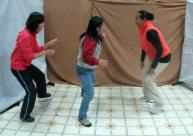
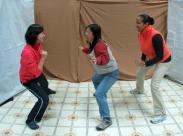
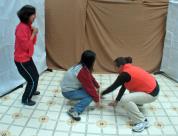
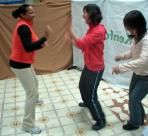
The images were taken during a workshop for teachers at HAC, Lamma, China.
Tragedy and comedy underwent major transformations after Rome occupied Greece. The chorus, preponderant in Greek theatre, was altogether abandoned in Latium. The tragedies in Greece were performed in the open so all citizens could watch. In Rome they were confiscated by intellectuals and the elite society, adapted to Latin and read aloud in private salons. The most notable playwright is Seneca.
Politics in Athens had changed radically even before the invasion of the Romans. After the death of Aristophanes writers of comic-satire were forced to avoid political issues, at least directly. Instead they turned to common folk caught in domestic issues and misunderstandings. The new style, immortalize by Terence and Plautus, was very popular with Roman audiences with plays in written in Latin and in the vernacular, albeit with no written dialogue.
Mime, the invention of the neighboring Etruscans, was a fundamental form of communication for comedians at the start of the Middle Ages. Banned from Latium by the Pope in Rome, they adapted the technique to make themselves understood as they traveled through Europe. Up until the Renaissance, for a thousand years, the word "mime" was used to describe all forms of acting.
The writers who borrowed the earthy stock characters from the Roman countryside set a trend that lasts to this day: the love triangle: A sees B and falls in love but B is betrothed to C by orders of her father/mentor. A enslists the help of D. With this deceivingly simple plot one can do just about anything. In some cases the theme was a cover to bring up social injustices. Beaumarchais, Mariveau, Goldoni, Rossini, Shakespeare, Molière are only some of the known authors who used this as a base for their work.
A triangle can also be a boss/employee/spouse, three co-workers, family members...
Click here to add text.
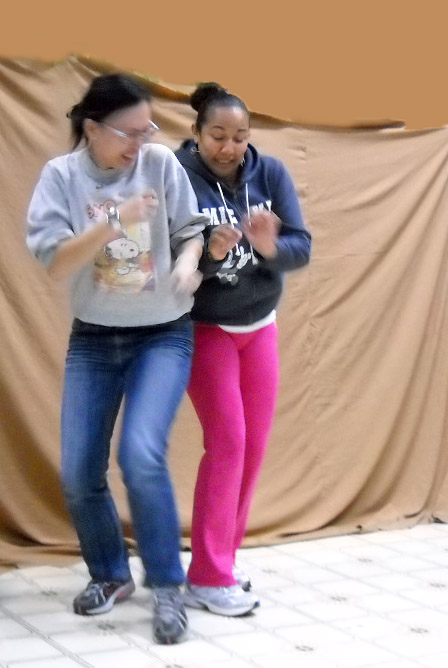
Blindfold Exercises
The following exercises increase the student’s sensory awareness and build trust within the group, besides helping them become better actors. After the first exercise ask them how it felt to be without eyesight. For the blindfolds I cut big strips of black material that taper at the end.
1
Students pair off, one has the blindfold. The second student must move the blind partner by means of taps on the back. On the right shoulder to turn right, on the left shoulder to turn left, in the center of the back to go straight and on the nape of the neck to stop. The seeing partner must avoid the other couples. Change roles.
2
The seeing partner guides by way of sound. Each pair choses a particular sound: zazazazazaza, wowwowwow, zoomzoomzoom...
3
One student pretends to be blind looking for a book (he knows in advance where it is). He is sent out of the room, the book is really hidden, he comes back blindfolded and must hunt it down. (The audience can help and encourage)
4
A table, chair/s, and personal items: book, newspaper, sunglasses, keys, a mobile (or two) a jacket, a hat...placed randomly around the stage. One student leaves the room and the objects are moved around (not the table and chairs). The student comes back blindfold with a latte cappucino for his boss. His mobile rings, it's his boss who tells him to pack everything in the suitcase as fast as possible. Everything! (The audience can help and encourage)
Pauses
Concentrate on freezing as often as possible
Actor A sneaks onstage facing the audience, as if sliding against a wall, to reach a window center stage. When s/he is close enough he leans his ear towards the window to listen in on a conversation.
B (offstage) calls him/her: Harry/ette! several times. The first time A ignores the call, then gets more aggravated as he tries to hear what is being said behind the window. He slides down and under the window, ear up.
B's calls vary: drawn-out like searching for someone in a forest, inquiring, pleading and angry which will follow with full sentences: Harry! You answer me right away, you hear me! As the words flow the voice recedes until it's gone. A listens to the conversation from the expression in his eyes we can tell he's surprised.
Make Believe
This exercise gives the illusion of pushing or pulling, or being pushed or pulled, when really the actors are balanced between each other. It's all appearances.
How many ways can you say: No, I don't want to! Yes, you have to!
What could have happened before and after this scene?
Before pushing B across the stage: A pulls B away from an imaginary doorknob.
After A pushes B across the stage: C appears from the opposite side, sees them and pulls B to him/her. A will not let go of B because C is not the intended person.
They (pretend to) pull B in opposite directions, pausing a moment at each pole. C tells B it's his interest to go with him/her, while A warns him of the dangers.
What happens before and after? It gets complicated.
Before A pulls B pull at an imaginary doorknob from either side. Remember not to clentch the fist, that there really is an imaginary doorknob. The push-and-pull is simoltaneous; feel the tension of the bodies pulling back while hanging onto the doorknob.
A has an idea (can look at the audience) and lets go of the doorknob. B is plummeted backwards, offstage. A goes after B and pulls him past the open door, where B catches on to the doorknob.......
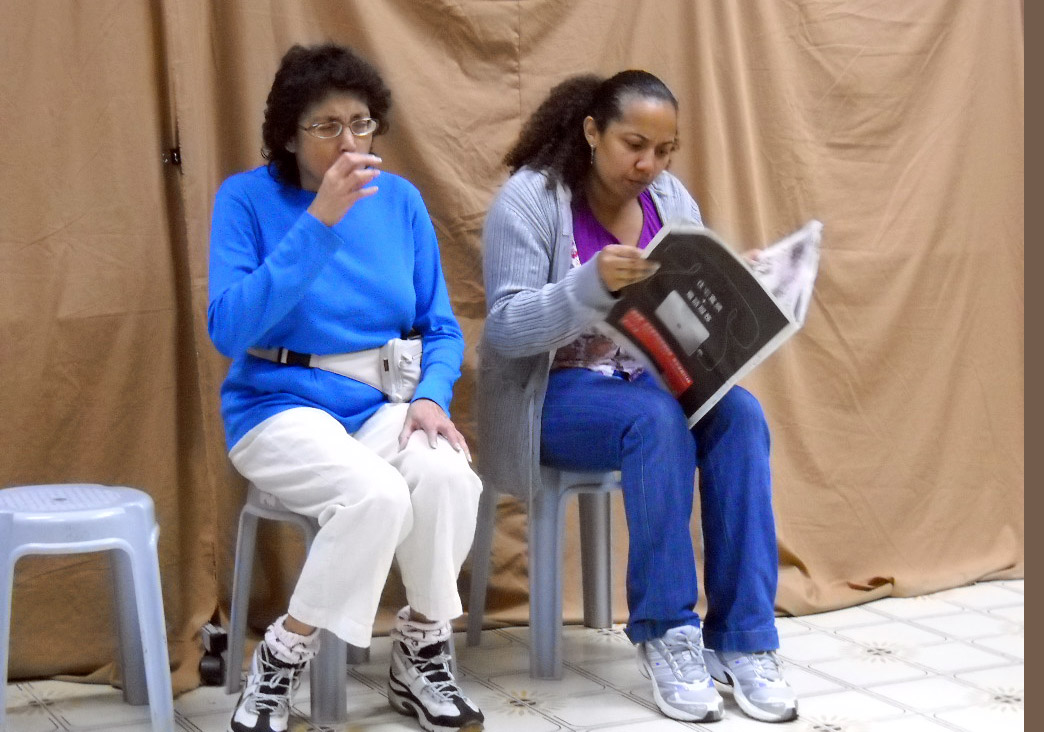
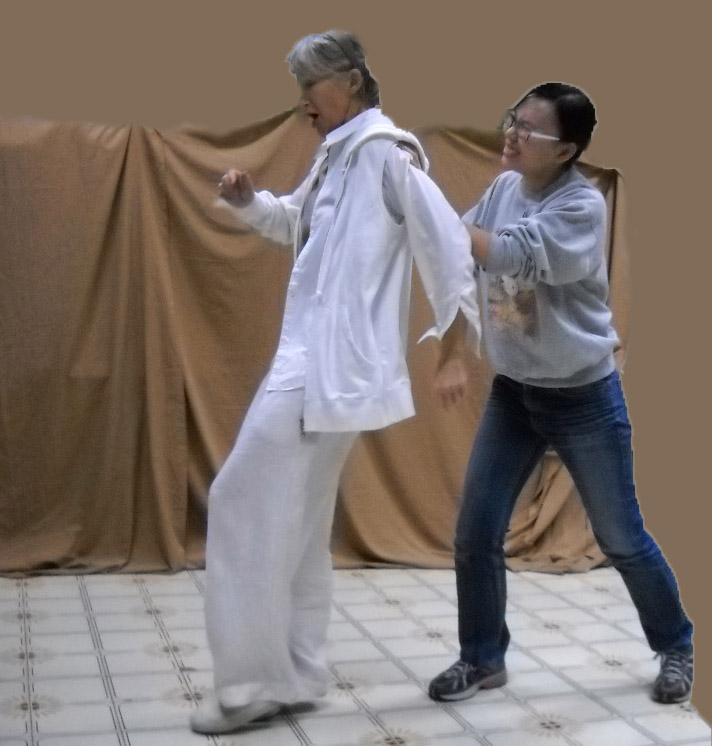
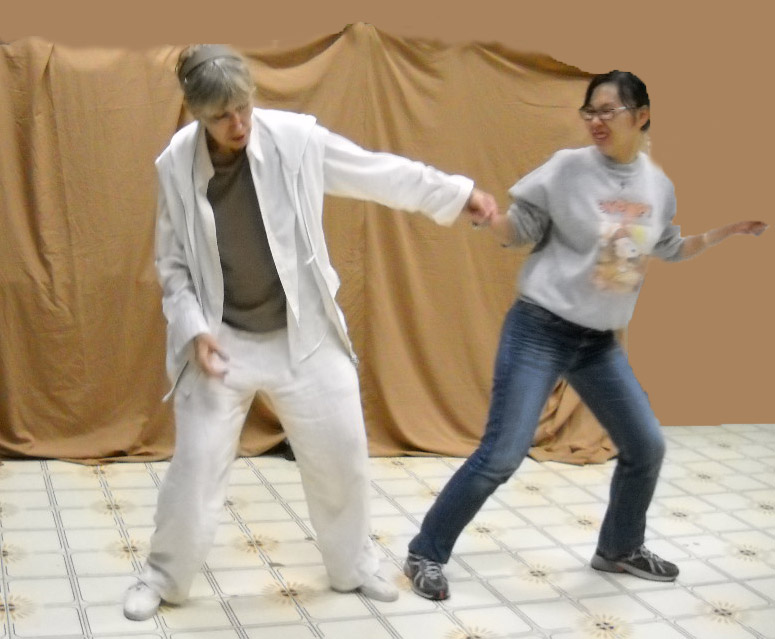
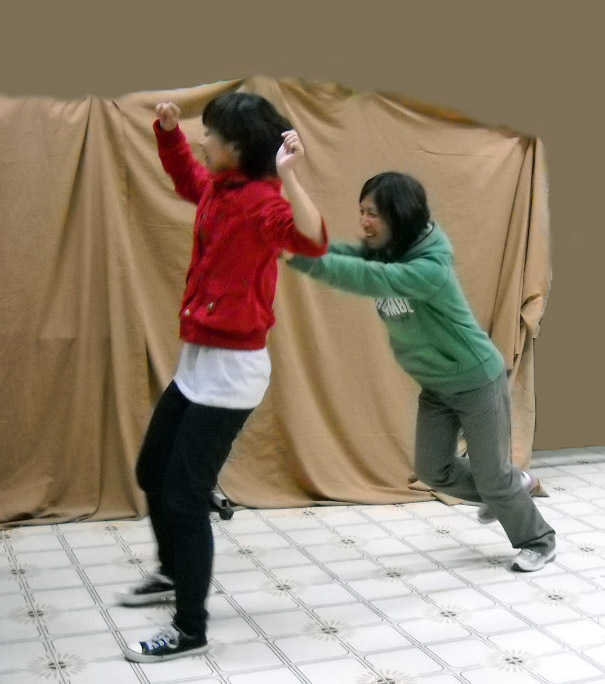
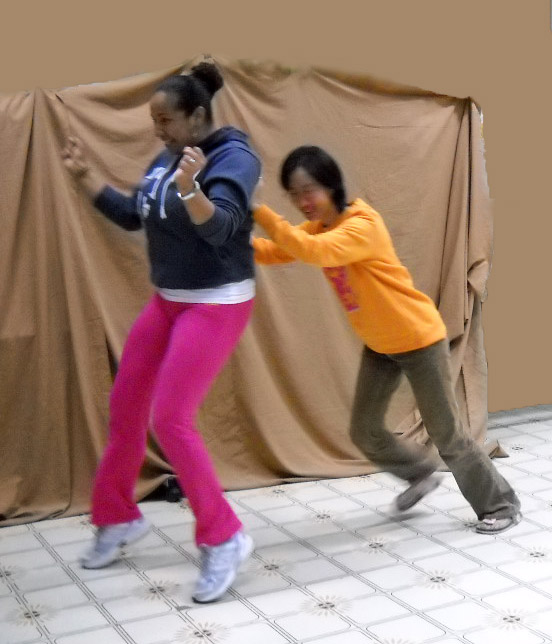
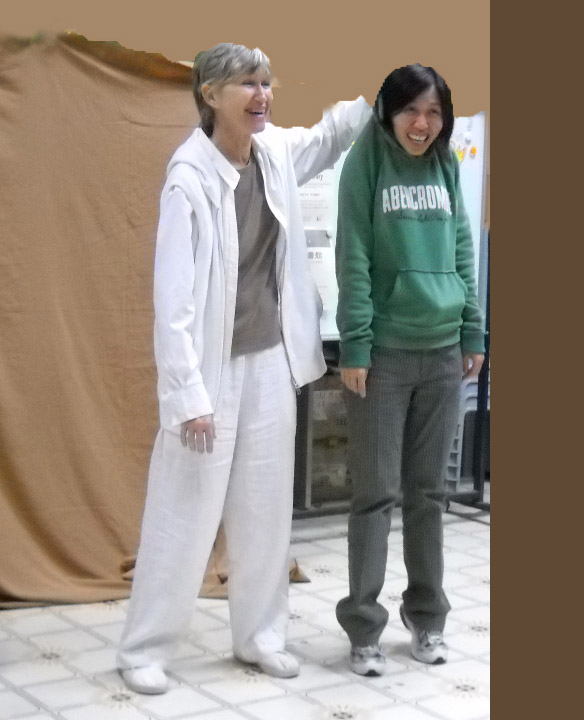
Movement, tempo and contrasts
Timing is everything. Once the actors have a good idea of what their characters should say and do have, them map out their movements independently. They must count their steps and see where to insert pauses. Choreograph the scene with the other actors. See how close you are to the other actors' timing and see how a time gap can be exploited in the scene: Circa three actors "see" a "suitcase" at different moments, and freeze until the others all see it, from their time zone. Ony then do all the actors move onto the next set of steps.
To keep the public's attention the movements are rather fast-paced with suddent pauses: A walks into a room searching for something when s/he sees an envelope on the desk. He freezes, looks at the audience, picks it up, opens it and starts to read. He hears a voice. Freeze. Concentrate.
Identify A by the way he/she moves. Does A walk in nonchalant as if he somehow belonged in the room, or is he in a hurry and fearful of getting caught? Does he hide the letter? How does he handle actor B when he/she walks in? Does he take control?
What happens when there are three people in the room looking for the same thing? Do they know each other, are they a team or competing? Do they, inividually or collectively have a back-up plan, or do they improvise as a group in case someone walks in?
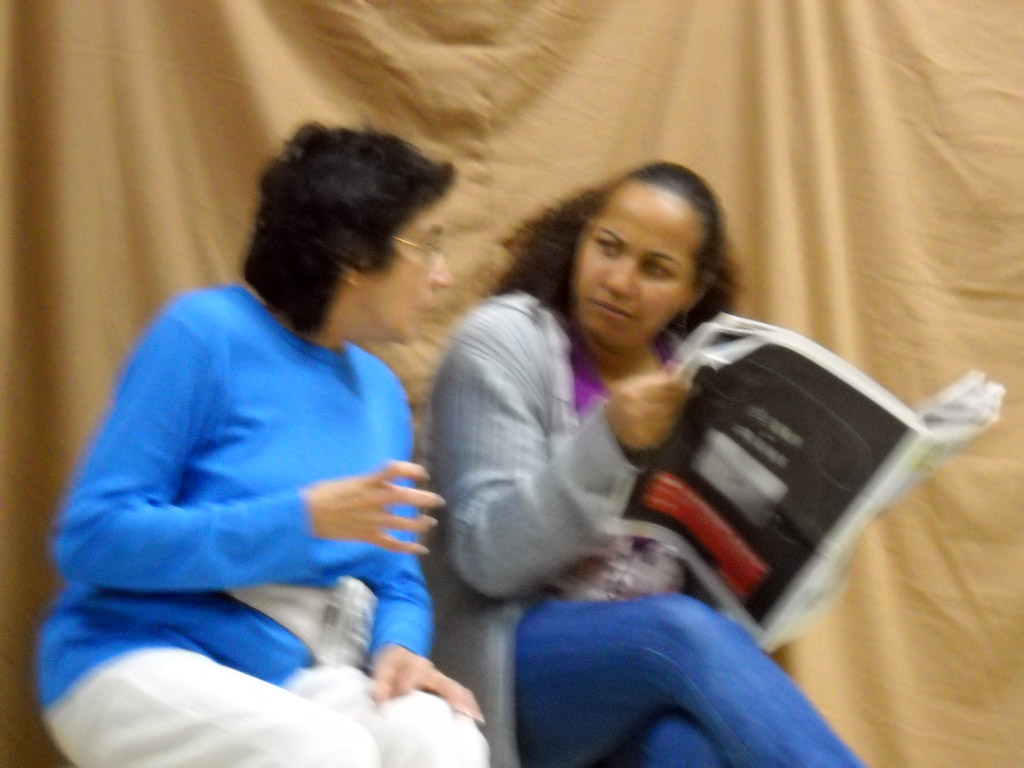
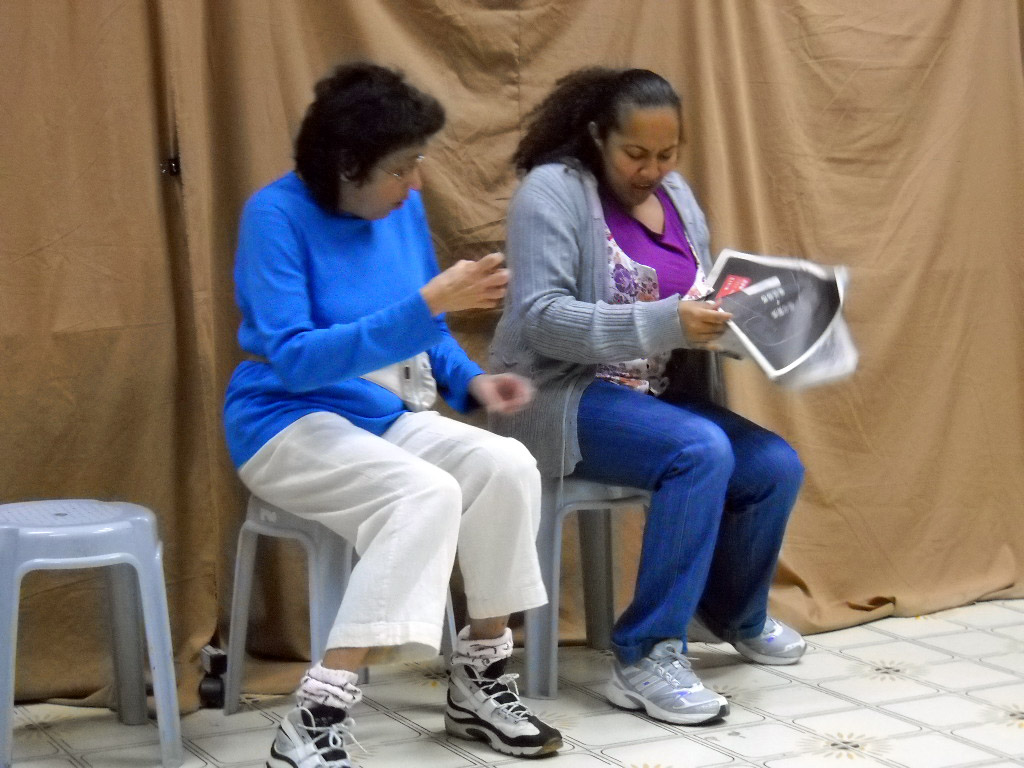
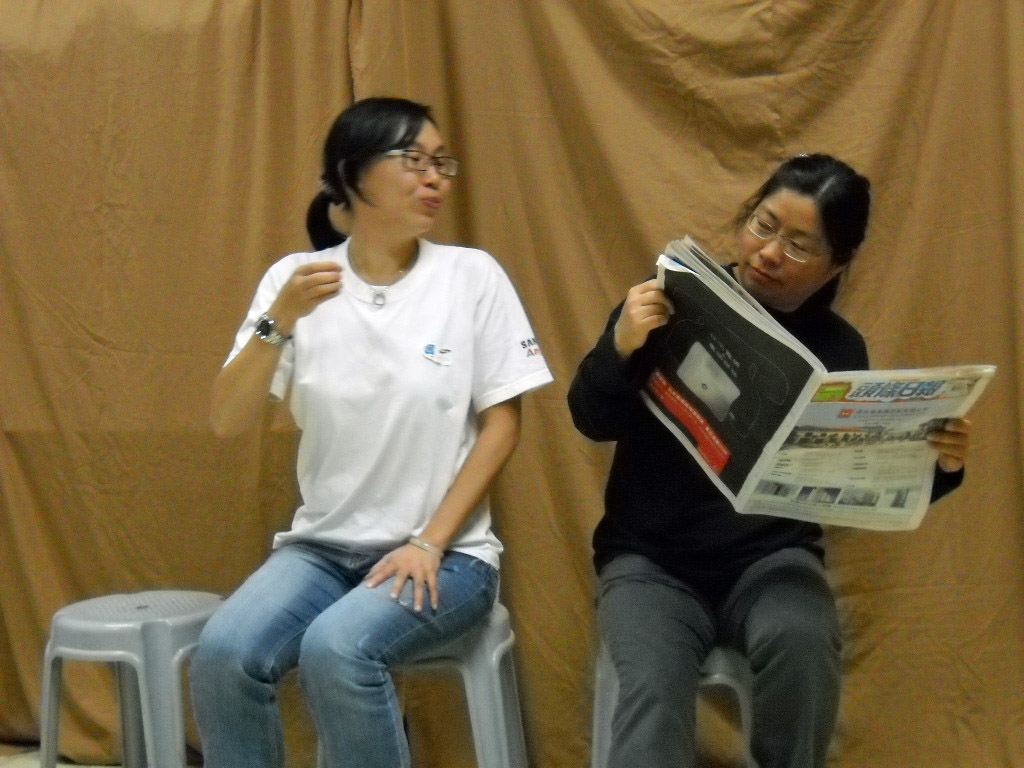
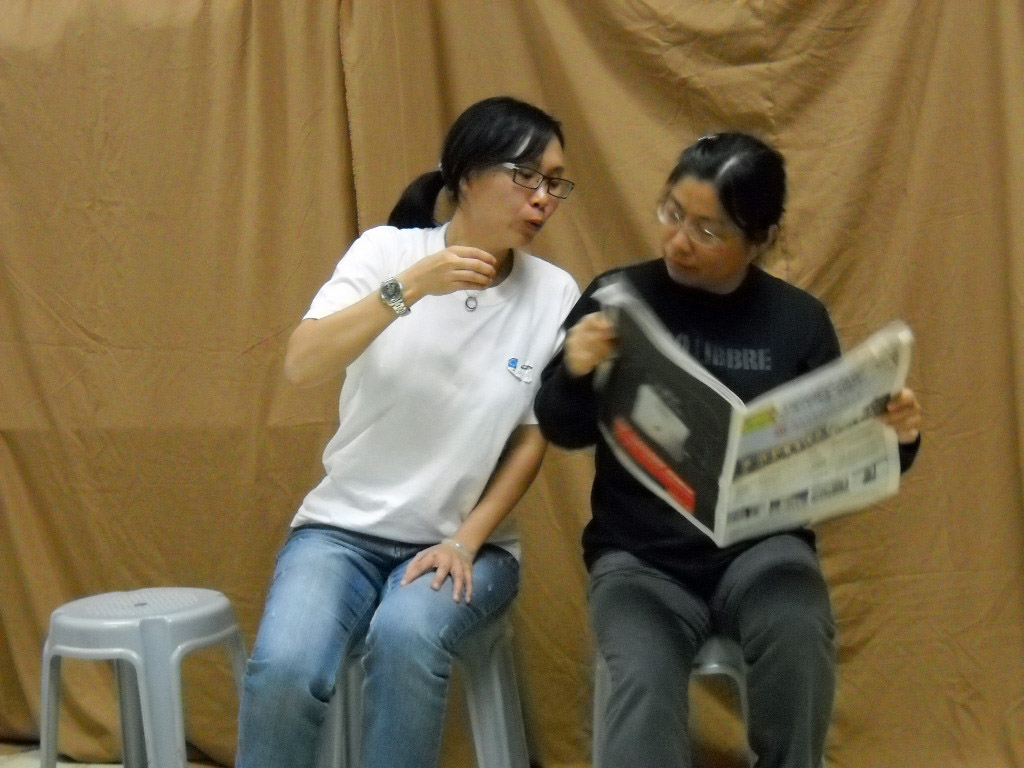
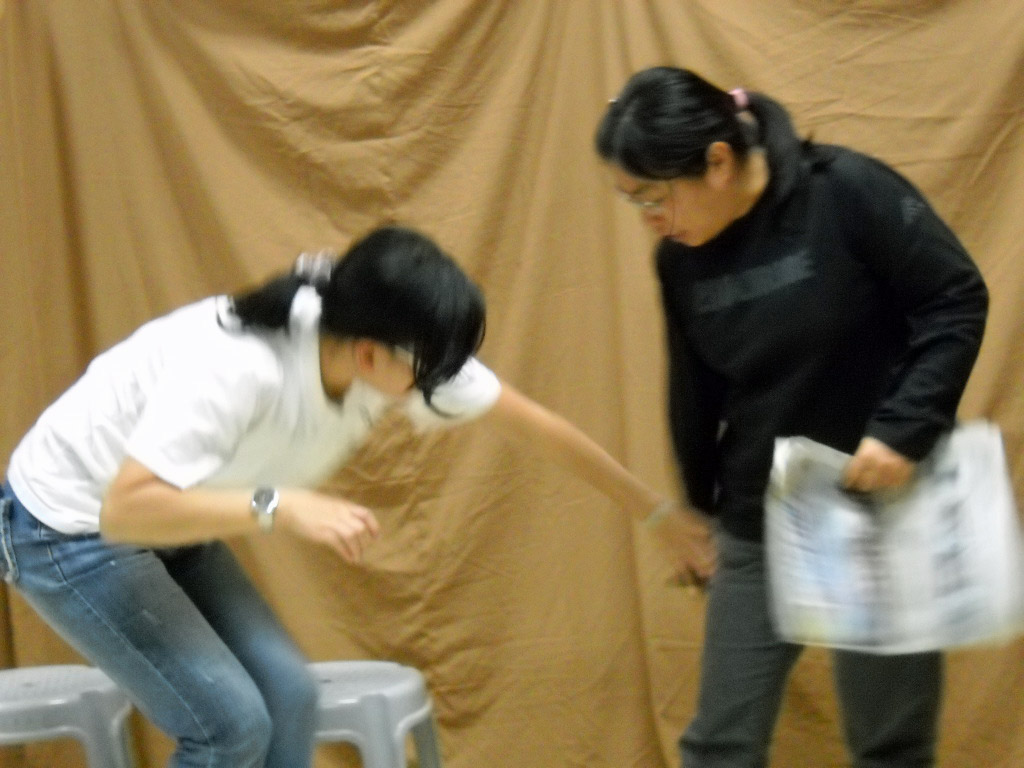
Summary of Plays
The door slowly opens (you know this because the guard is moving the imaginary door with his/her hand). A sees the guard and has alerts the other two to get the buckets, sponges and sprayers. The guard sees them washing the windows and leaves. They go back to searching when the guard opens the door suddenly. They freeze. He leaves to call the police and leaves, locking the door. They run to the window. The way they look down you know it's too high to jump.
2
A goes to the phone with the other two on either side. He pats his pockets for a number but can't find it. He racks his brain while the other two say..."I know it started with seven." "Not seven, seven was the second number." "I don't think so, I think it was the first number, then maybe two?".....
They hear the key in the lock and rush to their original position. The guard walks in and around them slowly. A feels the paper with the telephone number in his back pocket. The guard walks up to him, suspicious. He looks around A, who leans slightly so his back pocket is out of view. He looks on the other side, and leaves, again locking the door.
A pulls the number, rushes back to the phone, followed by the other two, and dials. An automated voice says "For for spanish press one, for german press two, for mandarin press three...All other languages stay on the line or press pound.." A presses. "Thank you for choosing English as your main menu, due to high volume there is a wait time of (another, metallic automated voice) twenty minutes, thirty-four seconds...twenty minutes, thirty-two seconds...)
3
What are you doing?
- Reply with a question of your own: What are you doing here? Does the boss know?
- Deviate the question: Aren't you hungry? Let's go to the kitchen. Did you check the laundry room?
- Pretend you're glad to see the person: You sure got here fast, did you catch him?
- Deviate with gesture: You don't want to come in here! We've been vaccinated but you...
Station Identification
1
Make a list of different television programs and movies: news, weather, reality shows, jerry springer, old cowboy movies, detective sitcoms, soap operas, boxing, the pope….
Actor A is the television screen, dozing.
Actor B sits (in a chair or on the floor) facing the “television”, back to the audience. S/he must communicate with the back facing the audience (leaning foreward and back with focus on shoulders, neck and head). He reaches for the remote that is usually on the “table” next to him.
The audience will understand what is going on by the way he taps his hand on the "table" to find the remote. Pause, tap around. Pause, think, tap some more, find the remote.
S/he aims the remote and pushes a button. B comes to life and acts out a station. Every time A points the remote, B changes stations: cowboy and indian, love scene, horror movie… (B must not change too fast or too slowly).
2
Study the different patterns in commercials. Team in groups of three or four to come up with a commercial to sell a product (of your choice). Find something surprising to make the audience remember your product (i.e. have a “real” person taste the dog food to show how good it is; hum, delicious!)
At the end list the negative side effects of a pharmaceuticals product while the image is all joyful: Can cause leukemia, thoughts of suicide, violent behavior, regression and blood poisoning. For a free sample…
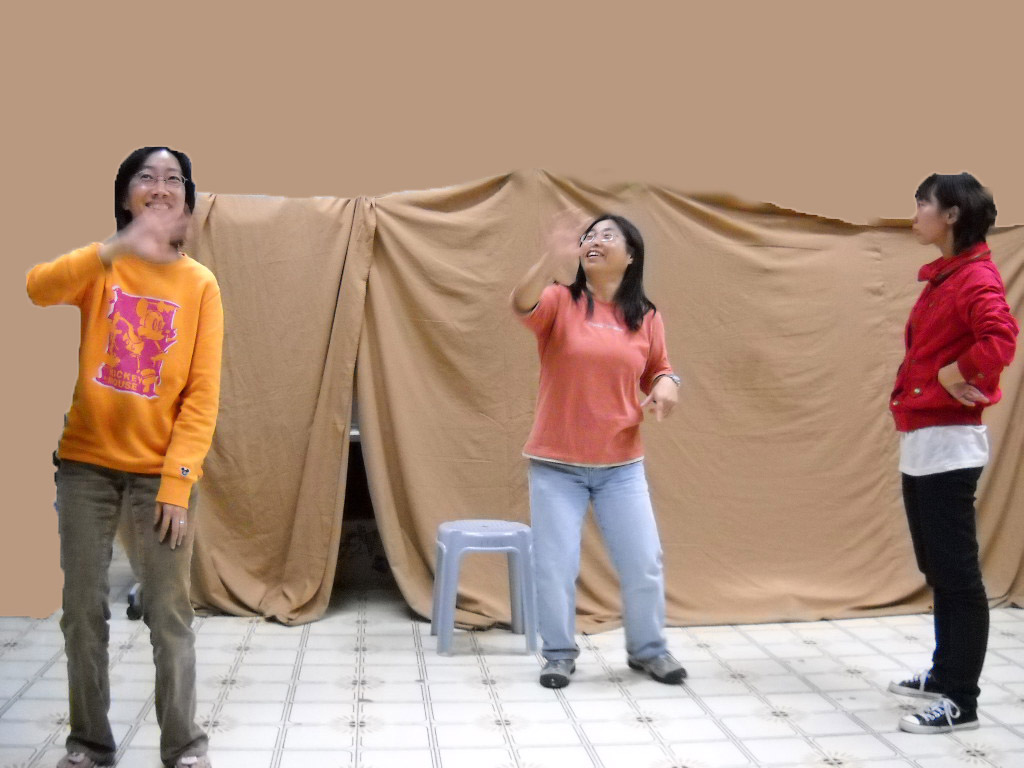
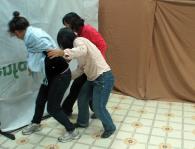
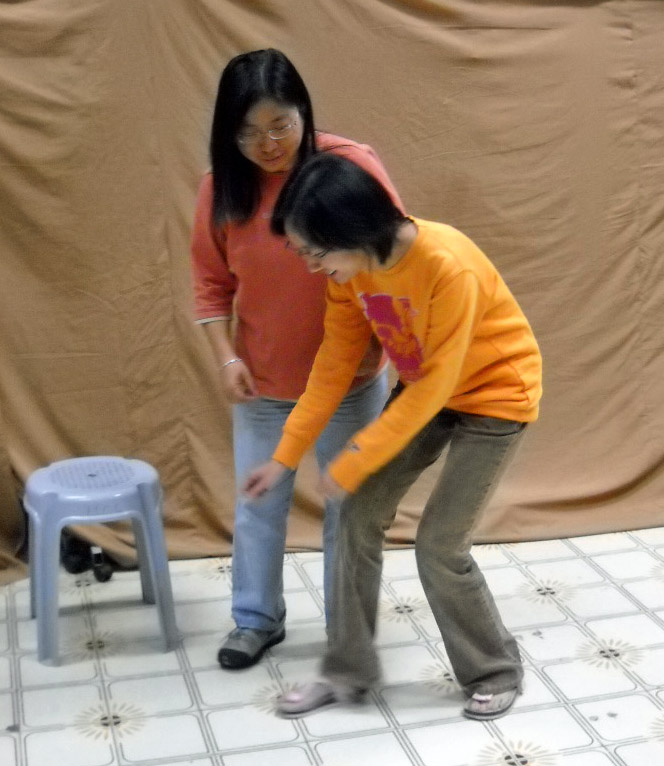
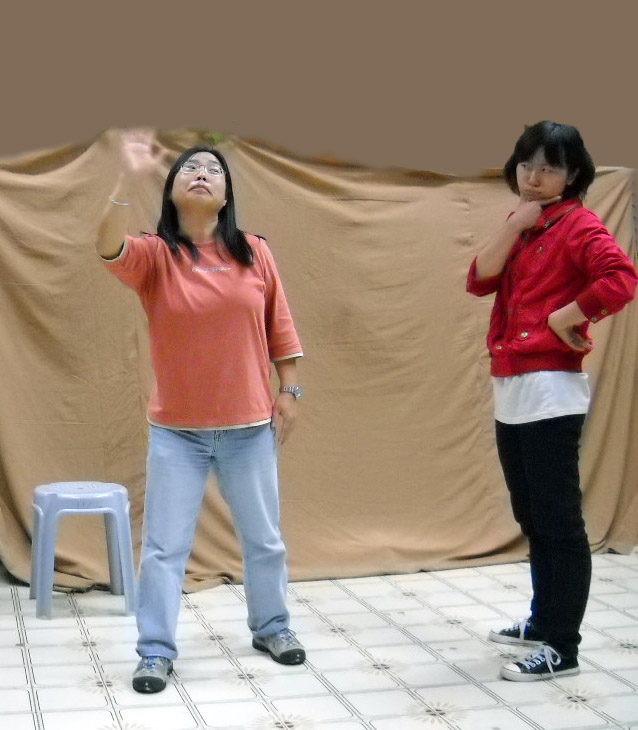

1
Three actors are sent to an office to find a file. A is the leader only because he's just a bit smarter than the other two, they are not professionals.
The other two actors ask A what to do and call him boss. A keeps telling them to stop calling him boss. They say okay boss.
Which ever way A moves the other two are right behind (unnoticed by him) with the exact same movements. A turns and almost has a heart attack when he sees them on him, and sends them off to look in different places, the desk drawers, the shelves, under the sofa...Where now? Anywhere!
The actions in this exercise should be rather fast paced. Find the pauses : While A is thinking where to start looking, when the other two scare him and when the guard comes in the second time... When the guard does walk in do they all see him/her at the same time? They have come prepared with (imaginary) buckets, sponges and little spray bottles for the plants.
Something to hide
Two actors
A and B will have picked from a box reasons to hide something. For A it will be what he thinks, or assumes, is the reason.
A thinks B is hiding something and asks questions indirectly starting with: How did your…….go? Day, evening, party, work, vacation?
Love Triangle
Seven actors
Write the first five scenes in Act One, based on the archetypal structure of the “love triangle” engendered by Menander. Then write the last five scenes in Act Two.
A sees B and falls in love, but B is betrothed to C by D, her father/uncle/trustees’ orders. A enlists the help of E. E, F and G can be anything: domestic, friend, family member, boss, co-worker or someone just passing.
Shakespeare used the love triangle for “A midsummer night’s dream”, and Beaumarchais for “Le Barbier de Seville”. From Beaumarchais Rossini borrowed “Figaro” for his popular opera “Il Barbiere di Seviglia”.
To get the students started create some scenarios in class where the answers are random. Either the characters are picked from a box, or the first answer to a question is chosen. If you want to have start with the original letter: Anthony, Bea, Charlie… Some names can be both genders: Al, Charley, Dan, Fred… Let’s say A is a blue collar worker.
1
Anthony
Anthony is a plumber in a big plumbing company. He is sent to a large house and as soon as he sees the owner’s niece Bea in the garden, he decides he wants to see her again. He knows that it will be difficult because of the difference in social status.
2
Anthony, Enrica
Anthony asks Enrica, a co-worker, for advice. She tells him Bea is getting married in three days, give it up. But how can he know for sure if he doesn’t try? He’d live the rest of his life wondering. He finally convinces her to help him find a plan. Enrica knows Fran, who is friends with the gardener George. Enrica can give Fran a note and make sure George gives it to Bea.
3
Bea, Donato
Bea and her uncle Donato are arguing. She refuses to marry to Charles, she doesn’t love him, he’s boring. D reminds her that C comes from a wealthy family. He’d promised his sister that he’d take care of her daughter. B thinks she should have enough from her trust fund without the support of a husband. She doesn’t know her uncle made bad investments with her money and lost most everything in Black Friday, why he’s so anxious for this marriage. Donato leaves and locks the door. Bea walks around in a fit of rage, fists clenched.
4
Anthony and Enrica meet with Fran. A didn’t know F was a woman, who didn’t look like she knew what she was doing, easily distracted stopping mid-movement or mid-sentence to go onto other things. A pulls E a part and shares his doubts about giving the note to F. E tells him not to worry. F has put tea on a chair and is sitting on the table. Still doubting A gives F the envelope. F invites them to share tea with her and E sits, takes a cookie and starts to pour herself some tea from the tray put A pulls her away, maybe next time. They exit.
Fred puts the envelope on the tray, picks it up, and the tea spills. She takes the wet envelop, puts it out to dry and leaves with the tray.
5
George, Bea
George will be handsomely paid to take the note to Bea but he’s complaining that it isn’t easy, she never goes out. He hears an argument from her room and goes under the high window but just as he gets settled the argument stops, a door is slammed and a lock is turned. He can hear Bea raging and he sees his opportunity. He finds a crate, overturns the contents, steps on it and cautiously peeks in the window just as she’s passing. It takes her a second or two to realize someone is looking through the window. She stops, hears a loud noise. She backtracks, looks out and sees George running off his head covered. Then she notices the tea-stained envelop on the sill. She opens it; the words are smeared beyond recognition. This gets her even angrier, if this is possible.
Define the characters
Anthony
Personality: outgoing, timid, impulsive, methodical…
Occupation: plumber
Is he close to someone in his family? Do they get along?
Recurrent gesture:
Do they have anything to hide?
Anthony is actually very wealthy but does not want someone to be with him for his money.
Enrica is actually an IRS agent who unveils Donato's shadowy business ventures.
Who else?
What would be an unpredictable outcome? A falls in love with E. C, who is kind and a gentlman, tells B he doesn't want to marry her, he doesn't love her, though it isn't true. This should make her happy but her ego is hurt and she sees her old friend under a new light...